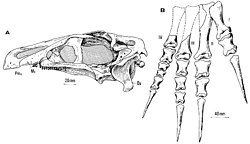
The timeline of therizinosaur research is a chronological listing of events in the history of paleontology focused on therizinosaurs. They were unusually long-necked, pot-bellied, and large-clawed herbivorous theropods most closely related to birds. The early history of therizinosaur research occurred in three phases. The first phase was the discovery of scanty and puzzling fossils in Asia by the Central Asiatic Expeditions of the 1920s and Soviet-backed research in the 1950s. This phase resulted in the discovery of the Therizinosaurus cheloniformis type specimen. Soviet paleontologist Evgeny Maleev interpreted these unusual remains as belonging to some kind of gigantic turtle.
Contents
- 20th century
- 1950s
- 1960s
- 1970s
- 1980s
- 1990s
- 21st century
- 2000s
- 2010s
- 2020s
- See also
- References
- External links
The second major phase of therizinosaur research followed the discovery of better preserved remains in the 1970s by collaborative research between the Soviets and Mongolians. These finds revealed the true nature of therizinosaurs as bizarre dinosaurs. However, the exact nature and classification of therizinosaurs within Dinosauria was controversial as was their paleobiology. When Rozhdestventsky first reinterpreted therizinosaurs as dinosaurs he argued that they were unusual theropods that may have used their clawed arms to break open termite mounds or collect fruit. Osmolska and Roniewicz also considered therizinosaurs to be theropods.
In 1979, Altangerel Perle named the new species Segnosaurus galbinensis , which although he recognized was an unusual theropod, he did not recognize as a therizinosaur. Consequently, he named the new family Segnosauridae and, in 1980, Segnosauria. Two years later, Perle recognized commonalities between Therizinosaurus and segnosaurs, reclassifying the former as a member of the latter. From hereout therizinosaur research was considered "segnosaur" research. Perle himself thought that his "segnosaurs" were semi-aquatic fish-eaters. However, in the early 1990s, researchers like Rinchen Barsbold and Teresa Maryańska cast doubt on the connection between therizinosaurs and segnosaurs altogether.
Nevertheless, the description Alxasaurus elsitaiensis provided more evidence for a close relationship between the therizinosaurs and "segnosaurs" and led to a revision of their classification. The discovery of this and other primitive therizinosaurs in China formed the beginnings of the third major wave of therizinosaur research. That same year Russell and Russell reinterpreted therizinosaurs as herbivorous foragers like mammalian chalicotherium. Other significant finds of the 1990s include therizinosaur eggs with embryos preserved inside and the first known therizinosaur with feathers, Beipiaosaurus , which was described from China in 1999.























